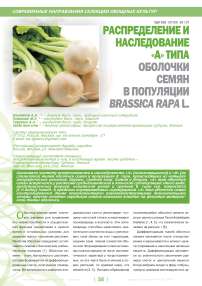Распределение и наследование «A» типа оболочки семян в популяции brassica rapa l
Автор: Игнатов А.Н., Павлова М.Е., Терехин А.А., Хида Кен-Ичи
Журнал: Овощи России @vegetables
Рубрика: Современные направления селекции овощных культур
Статья в выпуске: 4 (25), 2014 года.
Бесплатный доступ
Оценивали частоту встречаемости и наследуемость «A» (ослизняющегося) и «B» (не слизистого) типов оболочки семян в популяциях B. rapa, происходящих из четырех географических регионов: Европы, Средней Азии, Китая и Японии. «A» тип оболочки семян встречался у растений среднеазиатской и японской субпопуляций этого вида, представленных торией, азиатской репой и группой B. rapa ssp. nipposinica (L.H.Bailey) Hanelt. В пределах внутривидовых скрещиваний «A» тип оболочки семян контролировался двумя комплементарно взаимодействующими доминантными генами, причем генотип зародыша семени оказывал влияние на фенотип материнской ткани оболочки.
Короткий адрес: https://sciup.org/14025125
IDR: 14025125
Список литературы Распределение и наследование «A» типа оболочки семян в популяции brassica rapa l
- Windsor J.B, Symonds V.V, Mendenhall J, Lloyd A.M. 2000.Arabidopsis seed coat development: morphological differentiation of the outer integument. Plant Journal22: 483-493.
- Western T.L. 2012.The sticky tale of seed coat mucilages: production, genetics, and role in seed germination and dispersal.Seed Science Research22: 1-25.
- Yang X, Baskin J, Baskin C, Huang Z. 2012b. More than just a coating: ecological importance, taxonomic occurrence and phylogenetic relationships of seed coat mucilage.Perspectives in Plant Ecology, Evolution and Systematics14: 434-442.
- Western T.L, Skinner D.J, Haughn G.W. 2000. Differentiation of mucilage secretory cells of the Arabidopsis seed coat. Plant Physiology122: 345-356.
- Western T.L, Burn J, Tan W.L, et al. 2001. Isolation and characterization of mutants defective in seed coat mucilage secretory cell development in Arabidopsis.Plant Physiology127: 998-1011.
- North H.M, Berger A, Saez-Aguayo S, Ralet M.C. Understanding polysaccharide production and properties using seed coat mutants: future perspectives for the exploitation of natural variants. Ann Bot. 2014 Oct;114(6):1251-63 DOI: 10.1093/aob/mcu011
- Western T.L, Young D.S, Dean G.H, Tan W.L, Samuels A.L, Haughn G.W. 2004. MUCILAGE-MODIFIED4 encodes a putative pectin biosynthetic enzyme developmentally regulated by APETALA2, TRANSPARENT TESTA GLABRA1, and GLABRA2 in the Arabidopsis seed coat. Plant Physiology 134: 296-306.
- Zou H.F, Zhang Y.Q, Wei W, Chen H.W, Song Q.X, Liu Y.F, Zhao M.Y, Wang F, Zhang B.C, Lin Q, Zhang W.K, Ma B, Zhou Y.H, Zhang J.S, Chen S.Y. The transcription factor At DOF4.2 regulates shoot branching and seed coat formation in Arabidopsis. Biochem J. 2013 Jan 15;449(2):373-88 DOI: 10.1042/BJ20110060
- Esfandiari E, Jin Z, Abdeen A, Griffiths J.S, Western T.L, Haughn G.W. Identification and analysis of an outer-seed-coat-specific promoter from Arabidopsis thaliana. Plant Mol Biol. 2013 Jan;81(1-2):93-104 DOI: 10.1007/s11103-012-9984-0
- E Kondo M. Uber die in der Landwirtschaft Japans gerbauchten Samen. I. Ber. Obara Inst. Fur Lanw. Forsch. 1918, 1:2-32.
- Aoba T. Histological observation of seed coat in Brassica juncea Coss.//Japan. J. Breed. 1972, 22: 323-328 (на японском языке).
- Aoba T. Morphological observation of seed coat of the species belonging to Brassiceae. Bull. Yamagata Univ., Agr. Sci. 1971, 6: 315-324.(на японском языке).
- Aoba T. Characteristics of Asian turnips and their phylogenetical relationships. Agriculture & Horticulture 1987, 62: 63-64 (на японском языке).
- Shibutani S., Okamura T. On the classification of turnips in Japan with regard to the types of epidermal layers of the seed. J. J. Horticultural Soc. 1954, 22: 235-238 (на японском языке).
- Shibutani S., Okamura T. Studies on the morphological characters of seeds in Brassica. J. Hort. Ass. Japan. 1955, 24: 3-10 (на японском языке).
- Song K.M., Osborn T.C., Williams P.W. Brassica taxonomy based on nuclear restriction fragment polymorphism (RFLPs). 3. Genome relationships in Brassica and related genera and the origin of B. oleracea and B. rapa (syn. campestris). Theor. Appl. Genet. 1990, 79: 497-506.
- McGrath J.M., Quiros C.F. Genetic diversity at isozyme and RFLP loci in Brassica campestris as related to crop type and geographical origin. Theor. Appl. Genet. 1992, 83: 783-790.
- Sinskaia E.N. The oleiferous plants and root crops of the family Cruciferae. Bull. Appl. Bot. Plant Breed. 1928, 19: 1648.
- Yazawa S., Ueyama H, Namiki T. Simple method to distinguish seed coat type of Brassica campestris. Agriculture & Horticulture 1986, 61: 556-558. (на японском языке).
- Li C.W. The origin, evolution, taxonomy and hybridization of Chinese cabbage. In. P. Takelar, N.S., Griggs, T.D. (eds.) Chinese cabbage. Proc. 1st Int Symp Asian Veg. Res. Dev. Center. Taiwan, 1981: 3-9.
- Yazawa S., Ueyama H., Namiki T. Growing habit and longevity of seeds of Brassica campestris classified by their seed coat type. Agriculture & Horticulture 1988, 63: 1417-1419. (на японском языке).


